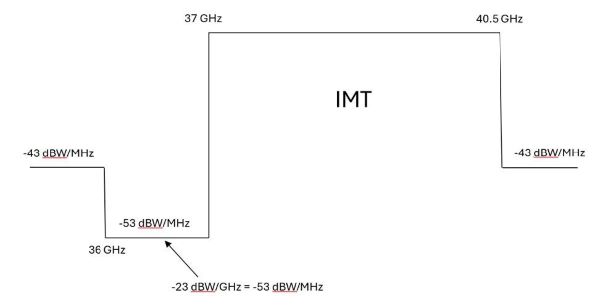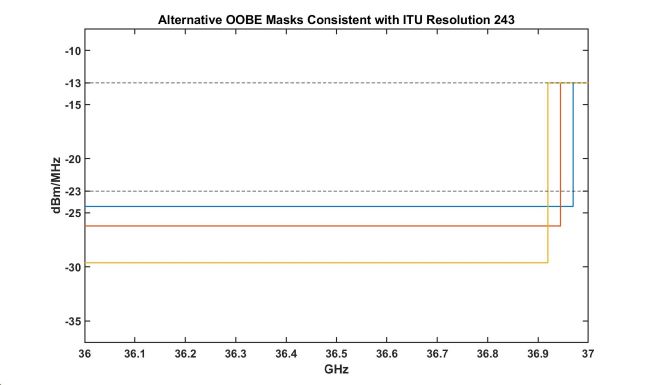Protect Adjacent Band Protection in Accordance with ITU Recommendations
Developing a National Spectrum Strategy
A critical issue is the need to protect operations in the adjacent 36-37 GHz band. Earth observations from environmental satellites serve a variety of purposes, including water and precipitation detection, and are leveraged extensively by DoD for mission execution, operational planning, and resource protection. Additionally, DoD shares environmental monitoring data with our Federal and international partners and works closely with the scientific community to assess impacts to passive band sensing.
The 36-37 GHz space-based passive sensor collects data to support:
- Ocean Surface Vector Winds: Used for resource protection, evacuation, and ship maneuver operations
- Cloud Liquid Water: Used for DoD Numerical Weather Prediction/Data Assimilation (NWP/DA) for both quality control and to assign uncertainty in “All-sky” assimilation of cloudy radiance
- Precipitation Rate: Used for operational weather assessment. Precipitation rate is an indication of soil moisture and ground condition that is needed for Army off-road mobility and land operations
- Snow Depth: Used for flood estimates, river gap crossing, and ground maneuvers
- Tropical Cyclone Intensity: Resource protection, evacuation, and ship maneuvers
- Sea Ice Characterization: Operational risk and safety for Arctic submarine and surface operations
- Imagery of 37 GHz data for tropical cyclone forecast and warning
- Numerical Weather Prediction (NWP) model directly assimilates 30 GHz data
Passive sensor observations in the 36-37 GHz band specifically support the U.S. Navy (USN)’s current and future battlespace awareness to assess impacts to afloat and coastal/littoral ship routing and mission operations, aircraft and flight operations, and overall resource protection of assigned assets and facilities. The Joint Typhoon Warning Center relies on these specific satellite observations as their primary means to assess tropical cyclones in data sparse ocean areas to assess impacts to DoD operations. Finally, the associated surface characteristic observations feed USG land information system models used by the U.S. Army for global trafficability forecasting as well as the USN and U.S. Air Force atmospheric and oceanographic models and forecast efforts used by every DoD warfighter daily for operations and resource protection.
DoD systems in the band include the Defense Meteorological Satellite Program (DMSP), whose mission is to collect and disseminate global, high-resolution visible and thermal cloud cover imagery, and other critical air, land, sea, and space environment data to DoD forces and the intelligence community. DMSP data is also furnished to the civilian community through the Department of Commerce. In addition, the Weather Satellite Follow-on is a Low-Earth Orbit microwave imaging system developed and delivered by the United States Space Force’s Space Systems Command. This program is designed to provide U.S. and Allied warfighters with essential weather data, including the measurement of ocean surface wind speed and direction, ice thickness, snow depth, soil moisture, and local spacecraft Energetic Charged Particle environment. NASA also has operations that rely on the 36-37 band, including the Global Precipitation Measurement (GPM) Mission, which is an important science satellite mission that operates passive sensors to measure Earth’s rain and snowfall and the INvestigation of Convective UpdraftS (INCUS) (planned for 2026). In the 36-37 GHz band, NASA missions also rely on data from EESS operations operated by other administrations, with examples from the Japanese Aerospace Exploration Agency (Global Change Observation Mission – Water; the Copernicus Imaging Microwave Radiometer (CIMR) constellation of 3 satellites planned for 2028; and Global Observing SATellite for Greenhouse gases and Water cycle planned for later this year. European Space Agency operations include the Copernicus Polar Ice and Snow Topography Altimeter planned for 2027 and the Sentinel-3 series. Further, beyond these specific examples, additional EESS (passive) systems operate in this band sponsored by other administrations.
In 2016, the Commission, with the support of NTIA, adopted an out-of-band emission limit that it concluded would “keep emissions from an UMFUS [Upper Microwave Flexible Use Service] device into the 36-37 GHz band well below the -10 dBW level specified by footnote US550A,” noting that the -10 dBW power limit “was adopted to protect passive sensors in the 36-37 GHz band in accordance with ITU Resolution 752 (WRC-07).”67 Under FCC Part 30.203, operations are limited to -13 dBm/MHz, which expands to -13 dBW/GHz. Subsequently, in order to accommodate and account for terrestrial International Mobile Telecommunications (IMT) in the band, WRC-19, with support from the United States, adopted Resolution 243 (WRC-19), summarized in Table 1 below.68 Resolution 243 recommends an OOBE limit of -30dB(W/GHz) and requires no more than -43dBW across any one megahertz and no more than -23dBW across the full one gigahertz.
Currently, the FCC’s rules (Part 30.203) limit out of band emissions below 37 GHz to -13 dBm/MHz. Referencing WRC-19 Agenda Item (AI) 1.13, this does not align with the levels recommended in Rec. ITU-R RS.2017. Protection to the levels of Rec. ITU-R RS.2017 is essential, considering the anticipated higher density deployment of fixed and mobile services that will result from the development of a sharing framework in the Lower 37 GHz Band.
NTIA recommends an administrative change to update the U.S. footnotes to reflect the WRC-19 Resolution 243, Table 1 (shown below as Figure 6).
TABLE 1
| Frequency band for the EESS (passive) | Frequency band for IMT stations | Unwanted emission mean power for IMT stations* | Recommended limits for IMT stations* |
|---|---|---|---|
| 36-37 GHz | 37-40.5 GHz | -43 dB(W/MHz) and -23dB(W/GHz) within the frequency band 36-37 GHz | -30dB(W/GHz) |
| * The unwanted emission power level is considered in terms of total radiated power (TRP). The TRP is to be understood here as the integral of the power transmitted from all antenna elements in different directions over the entire radiation sphere. | |||
Proposed footnote based on the interpretation of the Resolution 243 emission limits:
USXXX To protect stations in the Earth exploration-satellite service (passive), IMT stations operating in the range 37-40 GHz, shall not exceed total radiated power (TRP) of -23 dBW in the 36-37 GHz band and −43 dBW within any 1 MHz of the 36-37 GHz band. The TRP is defined as the integral of the power transmitted from all antenna elements in different directions over the entire radiation sphere.
Proposed inclusion of international footnote to communicate Res 243 recommendations:
5.550B The frequency band 37-43.5 GHz, or portions thereof, is identified for use by administrations wishing to implement the terrestrial component of International Mobile Telecommunications (IMT). This identification does not preclude the use of this frequency band by any application of the services to which it is allocated and does not establish priority in the Radio Regulations. Because of the potential deployment of FSS earth stations within the frequency range 37.5-42.5 GHz and high-density applications in the fixed-satellite service in the frequency bands 39.5-40 GHz in Region 1, 40-40.5 GHz in all Regions and 40.5-42 GHz in Region 2 (see, No. 5.516B), administrations should further take into account potential constraints to IMT in these frequency bands, as appropriate. Resolution 243 (WRC-19) applies.


Total Radiated Power (TRP) is the only acceptable way to measure compliance with these emission limits.69 Modern millimeter-wave systems have active beamforming networks that are integrated into the antenna array, making conductive testing not feasible due to the lack of physical space for measurement ports. A standard approach is important in estimating impacts to passive band sensing measurements. Noting that all passive sensor bands contribute to the overall accuracy of meteorological and space weather forecasting products and real-time situational awareness, it is recommended an evaluation of existing passive band protection is assessed based upon Rec. ITU-R RS.2017.70
The FCC Public Notice asked for comment regarding adjacent band protection to update FCC part 30.203 out-of-band emission (OOBE) criteria originally based on ITU Res 752 (WRC-07) to align with out-of-band emission limits consist with ITU Res 243 (WRC-19) for protecting 36-37 GHz Earth Exploration Satellite (passive) and Space Research (passive) primary services.71 Some potential users of Lower 37 GHz opposed revising the OOBE limits for the 37 GHz band, arguing that revising the limit could make existing equipment unusable.72 These comments, however, fail to provide information regarding the actual characteristics of the existing equipment, including any measurements of their actual OOBE or the roll-off of their emissions over varying frequency ranges; the cost of modifying the equipment if necessary; and any evidence that the limits adopted at WRC-19 are not needed to protect the nearby passive services. We would expect that in any follow-on FCC rulemaking interested industry stakeholders will provide such details.
In contrast to the industry comments, the National Academy of Sciences’ Committee on Radio Frequencies (CORF) stressed the importance of protecting the adjacent 36-37 GHz Earth Exploration Satellite Service band.73 CORF assessed that the current OOBE limits defined in Part 30.203 are barely sufficient to offer protection from a single 37 GHz transmitter within the entire footprint of a typical EESS (passive) sensor and urged immediate adoption of more stringent limits proposed in ITU Res 243 (WRC-19). CORF explained the natural thermal emissions being observed by microwave and millimeter wave remote sensing instruments are exceedingly weak, so interference thresholds are much lower than those for active communication systems. While active systems operate at signal-to-noise ratios, remote sensing receivers must measure changes in noise temperature of 0.1K or less. Because Earth remote sensing systems are total power radiometers, they have no way of distinguishing between natural thermal emissions these systems are designed to detect and in-band interference from artificial transmitters, unless the artificial signals rise to a level that causes a statistically or physically recognizable unnatural emission level. It is the lower level “insidious interference” that introduces unknown measurement bias into the remote sensing data. ITU-R RS.2017 establishes interference levels at which the consequences of this bias are at a tolerable level.74 Moreover, should an application emerge for the Lower 37 GHz band that would involve an average number of active transmitters exceeding 10 per 100 km2, CORF urged the Commission to consider other measures, such as further reduced OOBE limits or restriction to indoor operation, to ensure continued protection of the EESS (passive) observations in the 36-37 GHz band.
It is notable that DoD’s support for locating its 200 megahertz of priority spectrum at the low end of the band and its acceptance of the WRC-19 OOBE limits, demonstrates its commitment to protecting the passive services in the adjacent band and its recognition of the importance of those services.
Before there is any widespread deployment of facilities in the Lower 37 GHz band, it is critical that the concerns raised above be fully addressed.
67 See First R&O at para. 156.
68 Terrestrial component of International Mobile Telecommunications in the frequency bands 37-43.5 GHz and 47.2-48.2 GHz, Resolution 243, WRC-19.
69 This aligns with the measurement methodology based on the American Geophysical Union, American Meteorological Society and National Weather Association comments to FCC’s Emission Limits in the 25.25-27.5 GHz Band, ET Docket No. 21-186/GN Docket No. 14-177.
70 Since passive band data is combined across other passive band data to improve the accuracy of meteorological and space weather products it is important to look forward into ensuring the other passive bands are protected in line with Rec. ITU-R RS.2017.
71 See FCC Public Notice, WT Docket No. 24-243.
72 See Comments of CTIA, WT Docket No. 24-243 at 2, 4-6; Comments of NCTA, WT Docket No. 24-243 at 17-18; Comments of Ericsson, WT Docket No. 24-243 at 5; Comments of Verizon, WT Docket No. 24-243 at 6-7.
73 See Comments of National Academy of Sciences’ Committee on Radio Frequencies, WT Docket No. 24-243 (filed 27 Sep 2024).
74 See ITU-R RS.2017.
